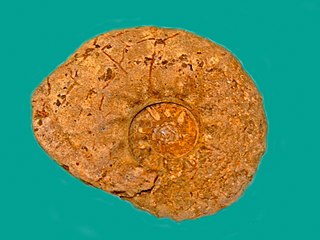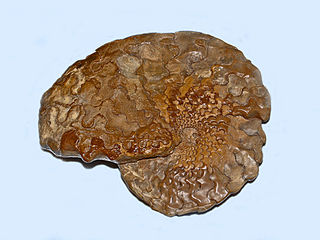Barremites is an ammonoid cephalopod belonging to the family Desmoceratidae, that lived during the Hauterivian and Barremian stages of the Early Cretaceous. Its shell is moderately to very involute, with the outer whorl strongly embracing the inner whorls, and variably compressed. Sides are generally smooth and marked with sinuous or falcate collars marking intervals of growth and bearing feeble striae to moderately distinguished ribs.

Barroisiceras is an acanthoceratacean ammonite from the Upper Cretaceous, Coniacian, included in the family Collignoniceratidae.
Zurcherella is a Lower Cretaceous (Upper Barremian - Upper Aptian desmoceratid ammonite from France and Colombia. Its shell is moderately compressed and rather involute, with fine sinuous ribs that arise some distance above the umbilical rim. Zurcherella differs from its descendant Uhligella in that in the latter, ribs arise from the umbilical shoulder.

Normannites is a strongly ribbed evolute Middle Jurassic genus of ammonite included in the stephanoceratoid family Stephanoceratidae.
Haplopleuroceras is a Middle Jurassic ammonite and likely member of the Hildoceratacean family Sonniniidae with which it shares the same sort of ribbing.

Stephanoceratoidea, formerly Stephanocerataceae, is a superfamily of middle- upper Jurassic ammonoid cephalopods within the order Ammonitida containing diverse forms, generally with sharp ribbing and complex suture lines. Aptychi are believed to be mostly granular (Granulaptycus) or concentrially ribbed on the surface (Praestriaptychus)

Tissotiidae is a family of ammonites (Ammonitina) belonging to the Acanthoceratoidea.
Subcollina is a genus of evolute to serpenticonic stephanoceratacean ammonites from the Middle Jurassic (Baj) of Mexico, placed in the family Spiroceratidae.
Coeloceratidae is a family of ammonites belonging to the Eoderoceratoidea that lived during the Early Jurassic. Shells are evolute, tending to be broadly discoidal with depressed whorls bearing primary and secondary ribs that branch from outer lateral tubercles. Most of the included species have coronate inner whorls and outer tubercles only. In general, Coeloceratids resemble the Middle Jurassic Stephanoceras. Once regarded as the subfamily Coeloceratinae in the Eoderoceratidae, these ammonites are now given familial rank.

Amaltheidae is a family of eoderoceratoidean ammonitids from the Lower Jurassic consisting of genera characterised by stigated discoidal oxycones—narrow involute shells with narrowly rounded to angular venters that bear a series of grooves, or ridges, along broad flanks, which according to the Treatise L, 1957, evolved into strongly ribbed planulates with quadrate whorls, typically with crenulated keels; involving all together four genera.
Crucilobiceras is an ammonoid cephalopod genus from the Lower Jurassic belonging to the eoderoceratoidean family Eoderoceratidae. Cruciliboceras has an evolute shell, such that all whorls are well exposed, with persistent radial ribbing and with spines or tubercles on the outer, ventral, rim, and in some, tubercles in the inner, umbilical, rim. The genus Crucilobiceras is commonly found along the Jurassic Coast of England.
Leymeriellidae is a family of Lower Cretaceous ammonites comprising rather small forms distinguished from Hoplitidae by their flattened and grooved ribs and virtual absence of umbilical tubercles. The family is derived from the Desmoceratidae. Leymeriella schrammeni anterior has evolved from Desmoceras keilhacki keilhacki.
Pseudohaploceras is a genus of desmosceratid ammonites from the Early Cretaceous; Valanginian to Albian epochs. The genus is distinguished by its moderately involute, slightly to moderately compressed shell with convex sides and regular straight or sinuous constrictions between which are fairly fine, distinct, sharp or rounded branching ribs extending from the umbilical edge and crossing the venter, the outer rim.

Holcodiscidae is an ammonite family placed in the Ammonite superfamily Desmoceratoidea.
Tragodesmoceras is a large moderately involute ammonite with deeply embracing whorls that are higher than wide, a steep sided umbilicus and a narrowly rounded venter. Ornament consists of primary ribs that begin at the umbilical shoulder and smaller secondary ribs that begin mid flank. Ribs are sigmodal, periodically thickened and bent forward on the outer flank to cross the venter as chevrons. The suture has a broad trifid lateral lobe.
Ochetoceras is a genus of ammonites, belonging to the Oppeliidae, that lived during the Late Jurassic from the early Oxfordian to the early Tithonian, and type for the subfamily Ochetoceratinae.
Erycitidae is a family of Lower and Middle Jurassic ammonites included in the Hildoceratoidea. The hammatoceratid subfamily Erycitinae is equivalent. Genera include Erycites (type) and Abbasites.

Hammatoceratidae is a family of lower and middle Jurassic ammonites included in the superfamily Hildoceratoidea.

Hammatoceras is a genus of ammonites belonging to the family Hammatoceratidae which lived during the Late Toarcian stage of the Early/Lower Jurassic between about 184 and 175 million year ago.
Flickiidae is a family of dwarf ammonites with little ornament and very simples sutures known from small pyritic specimens found in middle Cretaceous deposits. Inclusion in the Acanthoceratoidea is tentative.






